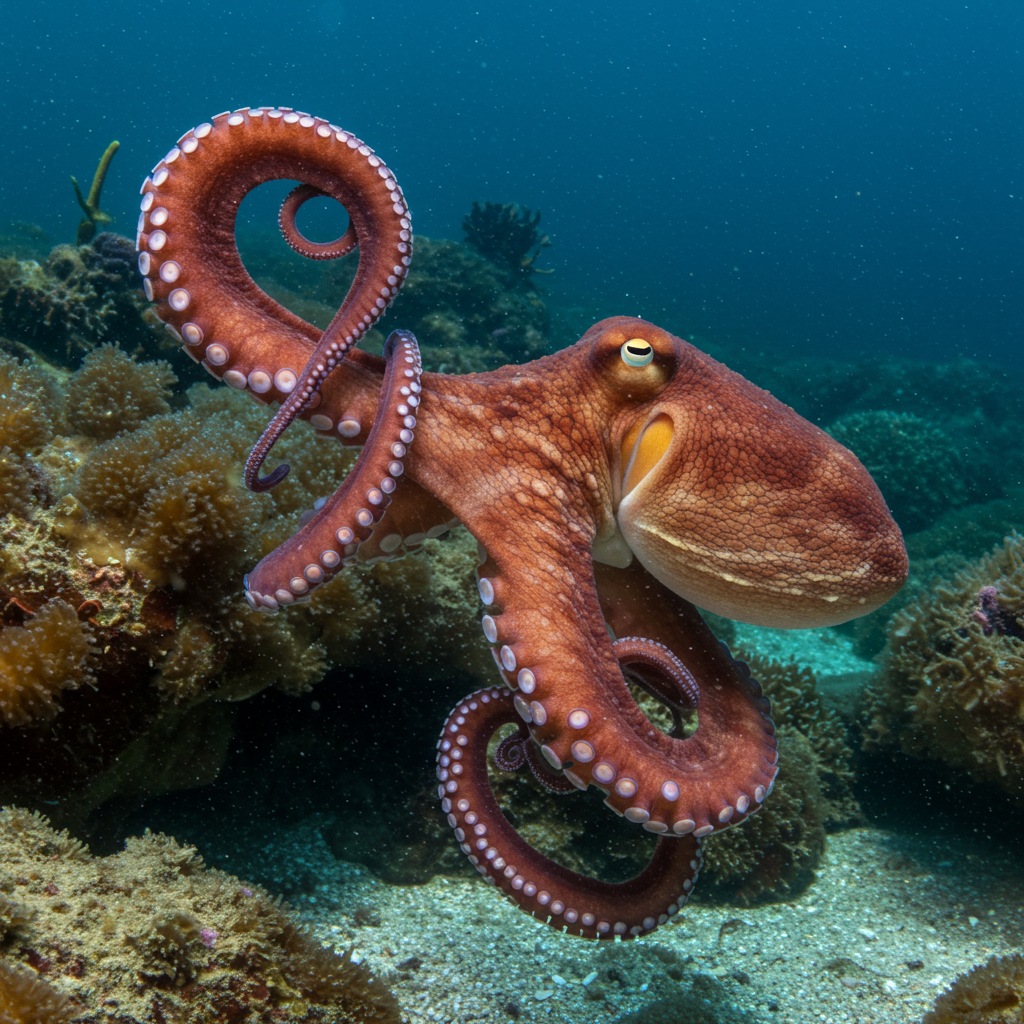Imagine coordinating eight incredibly flexible limbs, each capable of complex actions, across a myriad of tasks from hunting to building. This isn’t a fantasy, but the everyday reality for octopuses. These remarkable marine invertebrates, long celebrated for their intelligence and agility, now reveal another layer of sophistication: they prefer to use specific arms for particular tasks. This groundbreaking discovery redefines our understanding of octopus arm preference and motor control, positioning these cephalopods alongside species like primates and fish in demonstrating limb specialization.
Unraveling the Octopus’s Eight-Armed Enigma
Octopuses are true masters of movement. From delicately manipulating objects to powerful propulsion across the seafloor, their eight highly flexible arms execute a host of behaviors. While humans might struggle with “two left feet,” octopuses seamlessly manage eight, often simultaneously. This intricate coordination has fascinated scientists for decades, prompting deeper investigation into how these marine marvels operate.
A recent study, lauded as the most comprehensive of its kind, has shed significant light on this mystery. Researchers didn’t just document octopus movements; they uncovered a subtle yet profound strategy. This pivotal research, led by Kendra Buresch from the Marine Biological Laboratory in Woods Hole, US, unveiled that octopuses, much like many land and aquatic animals, develop preferences for certain limbs when performing specific actions. Published in the prestigious journal Scientific Reports, these findings offer unprecedented insights into the neural organization and behavioral complexity of these enigmatic creatures.
The Landmark Study: A Closer Look at Cephalopod Coordination
To unravel the intricacies of octopus arm preference, Buresch and her team meticulously analyzed 25 one-minute video clips. These clips featured 25 wild octopuses, representing three distinct species. The footage was collected over an eight-year period, between 2007 and 2015, from six diverse marine habitats. These locations ranged from the vibrant waters off Vigo, Spain, to the tropical reefs of the Cayman Islands. Such a broad scope provided a rich dataset reflecting natural octopus behavior in varied environments.
Researchers then embarked on a detailed classification process. They identified 15 different octopus behaviors, ranging from fetching an object to intricate den-building and various forms of locomotion. For each behavior, they pinpointed 12 distinct arm actions. These actions included specific movements like curling a limb or reaching an arm away from the body. Furthermore, the team investigated how the four fundamental ways octopus arms can deform—shortening, elongating, bending, and twisting—contributed to each action. This granular analysis allowed for an unprecedented understanding of their motor control.
The comprehensive data collection revealed that octopuses are incredibly adaptable. Despite identifying numerous specific actions, the study confirmed that all eight arms were fundamentally capable of performing all identified actions and deformations. This inherent versatility highlights the remarkable plasticity of their muscular and nervous systems, allowing them to adapt to diverse environments and unexpected challenges.
Specialized Limbs: Front vs. Rear Arm Preferences
One of the study’s most striking revelations was the discovery of clear functional differentiation among the octopuses’ arms. While there was no discernible preference for using right or left arms – suggesting a lack of handedness – the cephalopods consistently favored their front arms over their rear arms for most tasks. When all 12 identified arm actions were considered together, front arms were utilized in a significant 61% of instances, compared to 39% for rear arms. This indicates a purposeful, although flexible, division of labor within their remarkable limb array.
Delving deeper, the research pinpointed specific roles for these preferred limbs:
Front Arms (First Two Pairs): These limbs were predominantly employed for delicate manipulation and exploration. Actions like reaching, raising, lowering, and curling objects were frequently observed using the forward-facing arms. This suggests their front arms act as primary tools for interacting with their immediate environment, such as foraging or investigating novel items.
Rear Arms (Last Two Pairs): In contrast, the rear pairs of arms were heavily favored for actions related to locomotion and body support. Two key actions stood out: the “stilt” action, where the octopus’s body is held upright and elevated on its arms, and the “roll” action, where an arm moves in a conveyor-belt fashion to propel the animal. Both are crucial for efficient movement across varied terrains.
This specialized use of limbs, even though all eight are functionally equivalent, provides compelling evidence of sophisticated motor control and behavioral strategies. It suggests that while redundancy is built into their physiology, efficiency and task optimization drive their preferences.
Beyond Simple Movement: The Nuances of Octopus Dexterity
The fact that octopuses exhibit arm preference despite all arms being equally capable is a significant finding. It hints at an underlying neural architecture that prioritizes efficiency or minimizes cognitive load. Why expend energy on complex neural calculations to pick any arm when a preferred, specialized limb can achieve the task more readily? This suggests a highly evolved system where general capability is coupled with strategic specialization. The ability for multiple arm actions to occur simultaneously on the same or adjacent arms further underscores their unparalleled motor coordination.
This adaptability is a cornerstone of cephalopod behavior. It allows octopuses to thrive in diverse and often challenging marine environments. Their capacity to switch between specialized and generalized limb use provides an evolutionary advantage, enabling them to respond dynamically to their surroundings, whether it’s navigating complex crevices, escaping predators, or capturing elusive prey. This level of dexterity and flexible specialization is a hallmark of high-level intelligence and motor planning, aligning with other research suggesting advanced cognitive abilities in octopuses.
Why Does Specialization Matter? Implications for Science & Technology
The implications of understanding octopus arm preference extend far beyond the realm of marine biology. This detailed insight into how octopuses coordinate their eight flexible arms to execute complex behaviors and multitask efficiently has significant potential applications in various scientific and engineering fields.
For ethologists and neuroscientists, these findings offer a window into the evolution of complex motor control. By studying creatures with such a unique limb structure, researchers can gain new perspectives on how brains organize and execute movement, particularly in organisms lacking rigid skeletal structures. It provides a comparative model to understand neural pathways for dexterity and decision-making, complementing studies on vertebrates.
Perhaps most exciting are the potential benefits for engineers designing soft robotic appendages. The unparalleled flexibility, strength, and multi-functionality of an octopus arm are a holy grail for robotics. Traditional robots are often rigid and limited in movement. By understanding the biomechanics and behavioral strategies behind octopus dexterity – how they choose, deform, and coordinate their limbs – engineers can develop more adaptable, flexible, and efficient soft robots. Imagine robots that can navigate challenging terrains, manipulate delicate objects with precision, or perform complex tasks in hazardous environments, all inspired by the natural mastery of the octopus. This field, known as biomimicry, constantly seeks to learn from nature’s brilliant solutions.
Frequently Asked Questions
What tasks do octopuses prefer to use their front arms for?
Octopuses show a clear preference for using their front arms (the first two pairs) for tasks requiring fine manipulation and exploration. The study detailed that these limbs are most frequently employed for actions such as reaching for objects, raising them, lowering them, and curling around them. This suggests their front arms act as primary tools for foraging, interacting with their environment, and investigating new items.
Which research team uncovered octopus arm preferences?
The groundbreaking study that identified octopus arm preferences was led by Kendra Buresch, a co-author based at the Marine Biological Laboratory in Woods Hole, US. The research involved a team of colleagues and was published in the journal Scientific Reports. They conducted a comprehensive analysis of 25 one-minute video clips of 25 wild octopuses across three species to draw their conclusions.
How could understanding octopus arm specialization benefit future technology?
Understanding the specialized use of octopus arms, despite all being capable of all actions, holds immense value for fields like soft robotics and biomimicry. Engineers can leverage these insights to design more adaptable and flexible robotic appendages. Mimicking the octopus’s motor control and functional differentiation could lead to the development of robots capable of navigating complex, unpredictable environments and performing intricate tasks with greater dexterity, making them invaluable for applications ranging from exploration to medical procedures.
Conclusion: A Glimpse into Cephalopod Brilliance
The ocean’s depths continue to yield astonishing secrets, and the recent revelations about octopus arm preference are a testament to the sophisticated biology thriving beneath the waves. This study not only illuminates the intricate motor control of these fascinating cephalopods but also underscores their remarkable capacity for adaptation and problem-solving. By demonstrating task-specific limb usage, octopuses offer a compelling case study in natural efficiency and neurological organization.
These findings serve as a powerful reminder of the vast knowledge still to be gleaned from the natural world. From guiding advancements in soft robotics to deepening our appreciation for marine life, the octopus’s arm mastery provides invaluable lessons. As we continue to explore the capabilities of these intelligent invertebrates, we gain not just scientific data, but a profound appreciation for the ingenuity of evolution.




